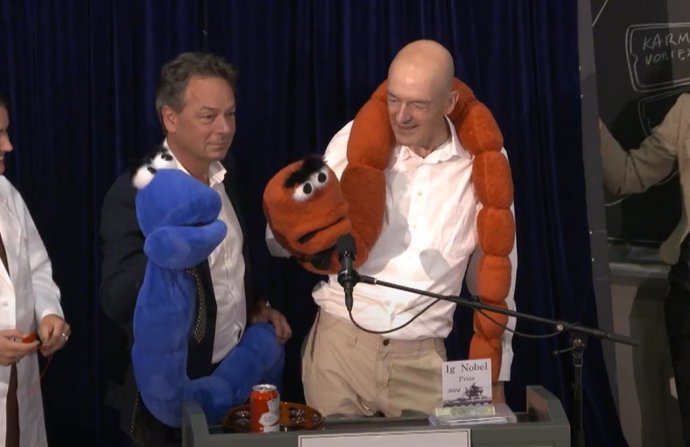Chemistry Prize Laureates – IG NOBEL
September 13 () –
An old World War II project that involved training pigeons to fly bombs is among the research awarded with the IG Nobel Prizes.
Awarded annually by the scientific humor magazine Annals of Improbable Research, These awards recognize unusual areas of research that “they make people laugh and then think.”
Burrhus Frederic Skinner, a psychologist at the University of Minnesota in the United States, was posthumously awarded the IG Nobel Peace Prize for his work on Project Pigeon, where he was able to teach pigeons to guide missiles with some success. But the project was never carried out due to skepticism from U.S. military and government officials, Dpa reports.
However, Skinner defended the research, writing in a summary of the project published in 1960:“Call it a crazy idea if you want. It’s one I’ve never lost faith in.”
The anatomy prize was awarded to a team of scientists from France who wanted to investigate whether the hair of most people in the Northern Hemisphere turned in the same direction (clockwise or counterclockwise) as that of people in the Southern Hemisphere.
Study author Khonsari Roman, professor of maxillofacial surgery at the Necker-Enfants Malades Hospital in Paris, said: “Overall, clockwise whorls are considerably more common worldwide. However, Counterclockwise eddies appear to be more frequent in the Southern Hemisphere.”
SEPARATING DRUNK WORMS FROM SOBER ONES
The chemistry prize was won by a research team that used a laboratory technique to separate drunk worms from sober oneswhile American scientists Fordyce Ely and William Petersen received the biology prize for blowing up a paper bag with a cat standing on the back of a cow with the aim of understanding more about how and when cows shed their milk.
The two discovered that Cows temporarily stopped producing milk when they were scared.
An international team of scientists led by academics in Germany collected the probability prize, which involved more than 350,000 coin-flipping experiments over a total of 650 hours and using 44 different coins.
The team discovered that When people flip a coin, the probability prize is 350,000 times. It “wobbles” in the air, making it more likely to land on the same side it started on.
Other awards included the Physiology Prize for discovering that Many mammals are able to breathe through the anus and the physics prize for demonstrating the swimming skills of a dead trout.
James Liao, a biology professor at the University of Florida in the US, said in 2004 that he discovered that The fish swim in a fluttering motion like a flag when towed behind a cylinder and wanted to see if dead fish did the same.
“The dead fish experiment was a quick way to demonstrate that just the shape, slime and flexibility of a (dead) fish is enough for it to harness energy to maintain the position behind the cylinder and even advance (by accelerating his body against his own resistance)”, he explained.
Liao said his work could help design better fish passages to help with their migration.
“I’m excited for more people to discover this, because at first glance the experiment sounds ridiculous, but then as you understand it better, the implications of this curiosity-driven scientific discovery are far-reaching and may also improve things that we humans hold dear.”
Meanwhile, the demography prize went to Saul Justin Newman, a senior researcher at University College London, who found that Some of the people with the longest lives came from places where records were poor.
Newman said he became interested in investigating data on humans living longer than most after debunking two scientific papers on extreme human aging.
“I found that extreme age records appear to be predominantly errors. These errors are evident from unusual patterns in individual cases, scientific studies, and entire populations. For example, the world’s oldest man, Jiroemon Kimura, has an extraordinary number of biographical anomalies and has three recorded birthdays: One that appears to have been faked, another that was a typo inserted by demographers, and another that is supposedly real.“, argument.
Newman said these anomalies are even greater when looked at in populations. “Reaching extreme ages is predicted by higher rates of poverty, higher rates of old-age poverty, not having a birth certificate, and, surprisingly, by having fewer people over 90 in a region, i.e., “The more 90-year-olds there are in a region, the fewer 105-year-olds there are.”
Newman said many of these people live in regions known as “blue zones” such as Okinawa in Japan, Sardinia in Italy and Loma Linda in California, where people are said to live longer and healthier lives than the average person.
He said: “These regions called the blue zones, including Okinawa, They seem to have been exploited to sell cookbooks and culturally appropriate lifestyle advice that is contradicted by independent data.”
Newman said Okinawa was promoted as a region that primarily eats vegetables and sweet potatoes, but added that “none of the lifestyle claims seem to hold up.”





![[Img #74661]](https://thelatestnews.world/wp-content/uploads/2024/12/The-power-of-ultrasound-150x150.jpg)







![[Img #74661]](https://thelatestnews.world/wp-content/uploads/2024/12/The-power-of-ultrasound-300x200.jpg)


Add Comment